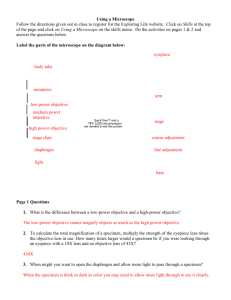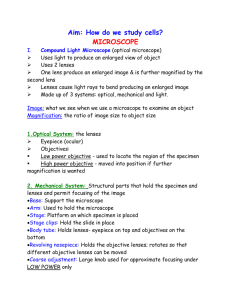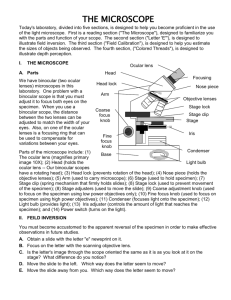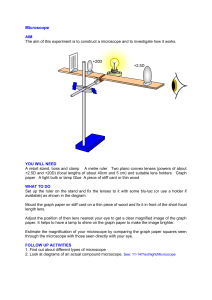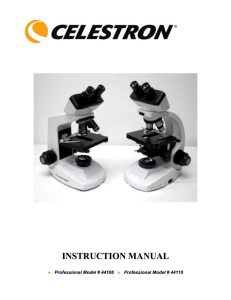USING A COMPOUND MICROSCOPE
advertisement
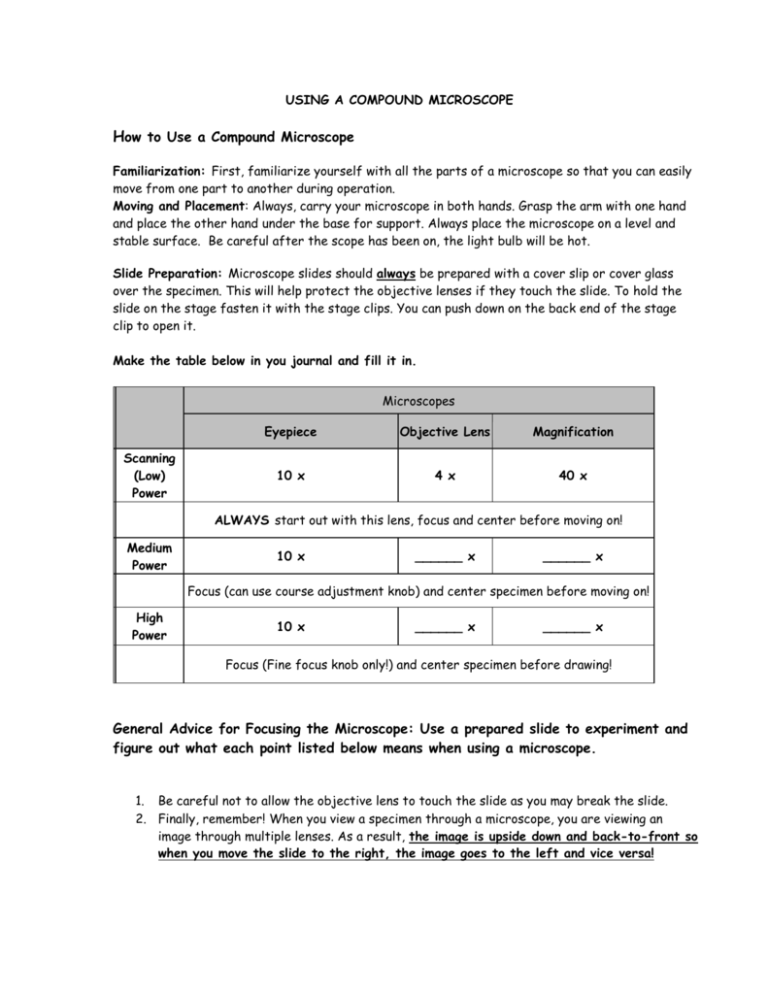
USING A COMPOUND MICROSCOPE How to Use a Compound Microscope Familiarization: First, familiarize yourself with all the parts of a microscope so that you can easily move from one part to another during operation. Moving and Placement: Always, carry your microscope in both hands. Grasp the arm with one hand and place the other hand under the base for support. Always place the microscope on a level and stable surface. Be careful after the scope has been on, the light bulb will be hot. Slide Preparation: Microscope slides should always be prepared with a cover slip or cover glass over the specimen. This will help protect the objective lenses if they touch the slide. To hold the slide on the stage fasten it with the stage clips. You can push down on the back end of the stage clip to open it. Make the table below in you journal and fill it in. Microscopes Scanning (Low) Power Eyepiece Objective Lens Magnification 10 x 4 x 40 x ALWAYS start out with this lens, focus and center before moving on! Medium Power 10 x ______ x ______ x Focus (can use course adjustment knob) and center specimen before moving on! High Power 10 x ______ x ______ x Focus (Fine focus knob only!) and center specimen before drawing! General Advice for Focusing the Microscope: Use a prepared slide to experiment and figure out what each point listed below means when using a microscope. 1. Be careful not to allow the objective lens to touch the slide as you may break the slide. 2. Finally, remember! When you view a specimen through a microscope, you are viewing an image through multiple lenses. As a result, the image is upside down and back-to-front so when you move the slide to the right, the image goes to the left and vice versa! 3. Place the slide on the microscope stage, with the specimen directly over the center of the glass circle on the stage (directly over the light). Then you have a 9 out of 10 chance of finding the specimen as soon as you look through the eyepiece! NOTE: If you wear glasses, take them off; if you see only your eyelashes, move closer. Be sure to close, or cover your other eye!! NOTE: If you see a dark line that goes part way across the field of view, try turning the eyepiece. That dark line is a pointer that will be very valuable when you want to point out something to your lab partner, or your teacher! 4. If, and ONLY if, you are on LOW POWER, lower the objective lens to the lowest point, then focus using first the coarse knob, then the fine focus knob. The specimen will be in focus when the LOW POWER objective is close to the lowest point, so start there and focus by slowly raising the lens. If you can’t get it at all into focus using the coarse knob, then switch to the fine focus knob. 5. Adjust the Diaphragm as you look through the Eyepiece, and you will see that more detail is visible when you allow in LESS light! Too much light will give the specimen a washed-out appearance. TRY IT OUT!! 6. Once you have found the specimen on Low Power (10x), unless specifically asked to draw it on low power, center the specimen in your field of view, then, without changing the focus knobs, switch it to High Power. If you don’t center the specimen you will lose it when you switch to High Power. 7. Once you have it on High Power remember that you only use the fine focus knob! Do not remove the slide when it is on High Power.” -- The High Power Objective (40x) is very close to the slide. Use of the coarse focus knob will scratch the lens, and crack the slide. You break it, you buy it! How To Make A Wet Mount: Answer the questions embedded in these instructions in your journal. 1. Cut a small piece of newspaper that includes a lower case “e”. Place the “e” on a slide so it is right side up. 2. Place ONE drop of water directly over the specimen. If you put too much water over the specimen, then the coverslip will float on top of the water, making it harder to draw the specimens as they float past the field of view! 3. Place the coverslip at a 45 degree angle (approximately), with one edge touching the water drop, and let go. 4. Focus on scanning power, center and focus on medium power. Draw the “e” as it appears when viewed through the eyepiece. 5. Have your lab partner move the slide away from your body while you are looking through the lens. Which direction does the slide appear to move when viewed through the eyepiece? 6. Have your lab partner move the slide toward the right while you are looking through the lens. Which direction does the slide appear to move when viewed through the eyepiece? Care & Maintenance of Your Microscope To correctly put the microscope away, you must complete the following basic steps: 1. When finished viewing, lower the stage, click the low power lens into position and remove the slide. 2. Switch off the microscope when not using. 3. Avoid touching the glass part of the lenses with your fingers. Use only special lens paper to clean the lenses. 4. Dust is the number one enemy of a microscope, so always keep your microscope covered when not in use. When not in use for extended periods, replace the microscope in its cupboard.


